




Magazine of Study
Association Esperia
Oude Kijk in 't Jatstraat 26
9712 EK Groningen
editorcie@svesperia.nl
Author
Editorcie 2022-2023
Editors
Ruben Feddes
Tiara Ruidavet
Stijn Bakker
Anne-Roos Peters
Bart Hans
Copyright © 2022 't Hartje
Korreweg 38
9715 AB Groningen
info@thartje.nl
Final Editor
Paula Divić
Ruben Feddes
Chair
Anne-Roos Peters
Commissioner of Acquisition and Vice-Chair
Tiara Ruidavet
Secretary
Bart Hans
Commissioner of Promotion
Stijn Bakker
Treasurer
Paula Divić
Final Editor
No part of this publication may be reproduced and/or published by means of printing, photocopying, audio tape, electronically or in any other way, without written permission from the publisher.
Welcome to the very first edition of this year's ETCetera! This edition might be a bit different to what you were used to from previous editions. Together with the Board, we have decided that this year we will revamp our magazines to be more academic and to make them more valuable. Of course, this does not mean we will bore you to tears with topics you already encounter in your daily academic work; we want to give you a magazine full of interesting articles and mini-essays on diverse topics. Starting with our first theme: European folklore and mythology.
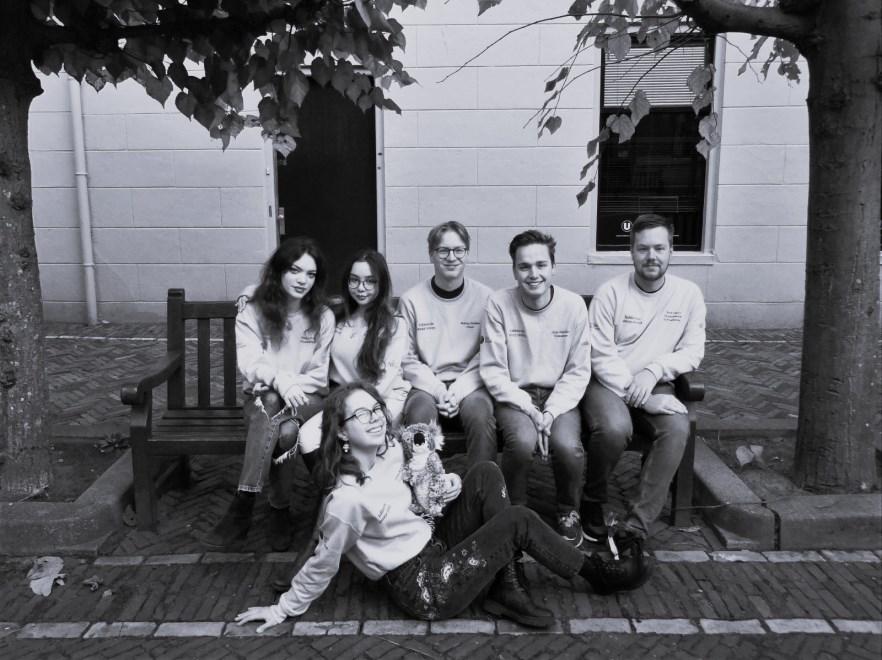
As the ELC programme has a large focus on literature, we wanted to capture a part of literature that may not get a lot of attention in our classes: folklore. Together, we wrote about so many different types of folklore: from our very own Dutch stories to Spanish birds, Scandinavian mythology, Greek snakes, Russian fairy tales, Irish folklore and much more. For people who loved our traditional ETCeteras, our Cooking with Koos segment is still here as is our lovely photo page.
We hope you enjoy this edition as much as we did writing it and let us know if you want any extra information on any of the topics, we all would be more than happy to talk to you about our new favourite tales and myths!
Love, the Editorcie
The days grow ever darker and the nights grow colder. Leaves increasingly disappear from the trees and birds are heading southward to warmer weather; the first period is over and the year is nearing its conclusion. Every student is looking forward to the Christmas period with all the lights motivating their study sessions, watching a movie or enjoying a drink with each other. It is during this time that the first ETCetera of the year is released and that you, hopefully with a cup of hot chocolate in your hand, now read these words.
As I sit here writing this introduction as Chair of the Board, I remember how I was asked to write this piece right after I won the personal article in the ETCetera at the Lustrum auction. Though it might seem a bit much to write two articles, I was more than happy to provide! Even more so, when I heard that the issue’ s topic was going to be folklore and I could write something about one of my interests - Greek plays. The articles in this issue cover a lot of interesting topics, like neo-paganism and of course the Charicie's annual charity of choice!
This year, the various committees have already organised some nice events, like the interesting lectures on the Dutch language by the Languagecie and of course the Introduction Camp by the Introcie back in September (wow, time goes by fast). I hope to see you at the com
+0+ing events during this year as well and of course at our Lustrum in April, which is inching closer with every passing day.
In the meantime, don’t forget to read this issue of the ETCetera. A great focus was put on providing a more academic magazine for Esperians and I am very impressed with how it turned out. I hope you also enjoy reading this issue and look forward to the other releases during the year!
With love, Sjoerd de Jong
Hey everyone! My name is Ruben and I will be leading this silly writing group this year ;). I am currently studying English Language and Culture. While it’s not ELC, it’s still closely related to the program. I love reading, doing the occasional workout and grabbing lots of drinks with friends. I am excited to work on the ETCetera’s this year and I hope that you enjoy them as much as I did while working on it!
Hey readers, I am Tiara, your residential Frenchie! I love knitting, reading, writing, binge-watching true crime documentaries, baking, dancing and travelling. The Editorcie is something I have been excited about as I was always in my schools’ journalism clubs growing up and I am also currently doing my minor in Journalism. I hope you enjoy our first issue!
Greetings everyone, my name is Stijn, a Sweden lover, socialism enjoyer, reading and writing enthusiast and Guinness connoisseur. After a year in the Editorcie 19/20, I am back to hopefully elevate the content of our beloved magazine with more ‘academic’ articles on subjects I enjoy. Nowadays, I study a minor in Journalism, which will hopefully turn into a master’s degree next year. I hope to see you around sometime!
Hiya! I am Anne-Roos, 20 years old and here for my second round in this wacky writing club we call our Editorcie! I am a part-time social butterfly and a true creative do-it-all, though I have always been most passionate about writing and storytelling. Other interests of mine include (but are not limited to) nature, advocacy, music and travel. Now, sit back, grab some tea and dive into the world of European folklore with us!
Hey everyone, my name is Bart. I’m the resident Tukker of the group, and I am happy to be back in the Editorcie for the second time! While I don’t follow ELC anymore as I moved on to my pre-master, I’m happy to still be related to Esperia. Some of my interests are mythology, politics, music, and nature. I hope that you will enjoy the ETCetera as much as we enjoyed working on it!
Paula Divić - Final EditorHello and welcome to the pages of this year's first issue of ETCetera. My name is Paula, I am 19 years old and this is my first time being a part of the Editorcie. I am so glad to have the opportunity to be the Final Editor since I love to read and write. In my free time, I also love spending time with friends and just doing anything that brings me happiness. I hope that this first issue will give you a surge of dopamine too!
Folklore and mythology might seem like stories of the past. Nowadays, we no longer believe in such nonsense. The stories are merely for us to enjoy them for what they are - historical fiction. You might believe so, and yet paganism, the belief in the gods and mythology of the past, is being revived in many parts of the world. For several reasons, the ideas of the past with their gods, spirits, rites and rituals feel welcoming again for believers today. Although this has had a mostly positive impact (a closer connection with nature, for example), these fringe Pagan religions can often lead to ideas more extreme in nature.
As I stated, in many parts of the world Neo-Paganism is making a resurgence, however, I will solely focus on Scandinavia in this article. Neo-Paganism is a revival of old Pagan beliefs, sometimes adapted to more closely fit our current ideas of the world and other times more abstract, such as a newfound passion for nature, in yet other cases it is a complete revival of the beliefs of yore. Norse Paganism, sometimes called Germanic Paganism, or by the name of their belief system simply “Asatru”, is the belief in the Norse gods and spirits. While I will not go into the specifics of Norse Paganism, I do highly recommend reading about it. It has many interesting stories, especially ‘Ragnarok’, the supposed end and subsequent rebirth of our Earth, the gods and the rest. The story is daunting yet inspiring. What must be understood about Norse Paganism is the fact that most aspects of life are the domains of certain gods, that rituals and offers are important and that runes have magical abilities.
The rebirth of Norse Paganism, from here on called Paganism, can be traced to the Romantic1 period. The rediscovered appreciation for nature, as well as a certain melancholic longing for the past, gave rise to the use of Paganism as a method of nation-building. Scandinavian nationalism was rooted in imagery around Viking culture, so along
Germany had the same effect. Being disillusioned with city life, with its heavy pollution and the loss of connection with nature, made longing for a simpler past more prevalent, especially among scholars of this period. As my other article discusses the early influences of these ideas leading up to and during the Second World War, I will skip that part in the timeline.
During the post-war period, some Neopagan groups, particularly the younger generation tried to cleanse their reputation of connections with Völkisch and other racist ideas. However, many Neopagans who were introduced to the beliefs through participation in festivals and rituals were ignorant of the problematic past of the revival movement. The groups that did manage to or claimed they managed to stay separate from the racist elements in the movement focused on the original written sources of their beliefs instead of the new text surrounding the ideas written by Völkisch and nationalist writers of the 19th century. They focused mostly on the connection with nature, and less so on the aesthetics and nationalist aspect of Pagan beliefs. The rise of the Internet gave further rise to Neopagan movements. People were able to form new (online) communities surrounding their beliefs and even create ones in real life. In Scandinavia, groups such as Samfundet Forn Sed Sverige (Community of Forn Sed Sweden) in Sweden and Åsatrufellesskapet Bifrost (Asatru Fellowship Bifrost) in Norway, work hard to detach Pagan symbolism and ideas from farright beliefs. They consider themselves activists for nature and try to educate on the importance of harmony with the world surrounding us. They see Paganism and its rituals and traditions as a method to create a stronger bond between humans and nature.
On the other hand, Paganism still has strong roots in many fringe farright communities. Norse runes and imagery can often be found in logos of these communities, while the “nostalgic” feeling Paganism invokes in some individuals is often used in the ideas that extremist organisations have regarding nation and race. Specific runes, such as the othala, tyr and elhaz, have been used by Nazis and neo-Nazi groups since. These runes, originally Pagan and usually connected to a specific aspect of the world such as life, death or birth, have nowadays been given different meanings by these groups.
Elhaz, or the life rune, for example, is used to show pride in Aryan heritage and was used for a Nazi-project to kidnap Aryan children as well as have children with “Aryan” mothers out of wedlock.
Northern neo-Nazi or other far-right groups furthermore adhere to the belief that Scandinavia should be Pagan. For example, the Sweden Democrats, the far-right political party currently supporting the government, adhered to the same beliefs upon formation. However, they later abandoned this idea to become a more mainstream party and adopted the belief that Sweden should be Christian instead. The “Nordic Resistance Movement”, a far-right Scandinavian organisation, wants to create a Nordic Pagan ethnostate. Their logo is two merged runes, further confirming their Pagan beliefs.
More people find that Paganism, especially its specific connections with the nature surrounding us, can have a positive impact on climate resistance and sustainability practices. In a world that is constantly changing and seems to go by faster than we can process, it is certainly understandable that rituals in nature and the connection it brings might be liberating for a lot of people. On the other hand, the Pagan movement has had many issues in the past. Nowadays, these far-right groups are becoming more fringe, but their ideas remain. A newfound connection with nature can only be applauded, and yet there is more to the story. The revival of Paganism can have a positive impact on our understanding of nature, as long as we are aware of the flipside.
Book: Norse Mythology by Neil Gaiman (ask Stijn, he has a copy to lend)
Book: Norse revival: transformation of Germanic neopaganism by Stefanie
von SchnurbeinArticle: “Embodying ‘the Nordic race’: imaginaries of Viking heritage in the online communications of the Nordic Resistance Movement” by C.
KølvraaWhen thinking of Irish folklore, you probably think of the ol’ leprechaun sittin’ in a pot o’ gold at the end of the rainbow, surrounded by four leaf clovers. In the legends however, these creatures are highly mistrustful of humans, burying the gold away from them. Certain elements from Irish folklore are omitted, which in my opinion is a terrible waste, as Ireland holds much folklore and mythology that really is worth diving into. Tales of banshees, the tale of the Giant’s Causeway, or how the Cycles of Irish Mythology each have their own unique stories!
Starting off with the latter, the Cycles of Irish Mythology is the name for the four cycles in which Irish mythology falls. The earliest cycle in Irish mythology is the Mythological Cycle. It revolves primarily around stories that feature ‘godlike beings and peoples.’ Many stories of the Mythological Cycle feature the Tuatha Dé Danann, a mythological Irish race, which translates to “tribe of the gods.” The second Cycle is the Ulster Cycle, which many say took place around the first century, featuring tales of warriors and battles. A well-known tale is the tale of Cu Chulainn, who is described to be the greatest Irish warrior of all time. The third Cycle is the Fenian Cycle, which focuses on the great warrior Fion Mac Cumhaill. The story of him and the Salmon of Knowledge is still a prominent story to this day and definitely worth a read. Finally, we have the Historical Cycle, which blends history with mythology. It starts after Saint Patrick came to Ireland and is said to be influenced by Christian teachings. Its main characters are Labraid Loingsech and Brian Boru, the former being a mythological character and the latter being a real person.
The next piece of folklore is a creepy one, that being the tale of the banshee. This story originates from around the 1380s, first mentioned in the Cathreim Thoirdhealbhaigh by Sean mac Craith. The banshee is a female spirit who heralds the death of a family member, usually by screaming or wailing. A banshee is often depicted with long hair and a grey cloak, with red eyes from continual weeping. Different records of a banshee’s depiction also show differences in her looks, as some describe her dressed in white with red hair, or as unnaturally tall or short. The legend of the banshees is intrinsically linked to mythologically important tumuli, or burial mounds, which dot the Irish countryside and many other places around the world. This could also explain why there are mentions of banshees in Norse folklore.
Finally, we have the tale of the Giant’s Causeway. This is a location in Northern Ireland that you can visit, and it comprises about 40.000 basalt formations interlocking with each other to form a spectacular landscape that is known around the world. Of course, the scientific explanation is nice, but Irish folklore also had their explanation for how this unnatural landscape was created. As legend has it, Northern Ireland was once the home of Finn McCool, a giant. When another giant, Benandonner, threatened Ireland, Finn retaliated by tearing up great chunks of the Antrum coastline (which is where the Causeway is) and hurling them in the Irish Sea. This newly created path – the Giant’s Causeway – paved a route across the sea for Finn to reach Benandonner. However, Benandonner was a much bigger giant than Finn was, so Finn disguised himself as a baby, making Benandonner think that the father of the baby would be much larger. Benandonner then retreated to Scotland, tearing up as much of the Causeway as he could to prevent Finn “and his “father”” from coming to Scotland. And that is the myth of the Giant’s Causeway.
Irish mythology has plenty of other stories, so please, do yourself a favour and look into them. They have folklore of all kinds: scary monsters, fairies, leprechauns – the entire lot!
Do you find yourself knocking on wood often to prevent jinxes? Or fearing for your life and safety after seeing a black cat cross the road?
By definition, superstitions are beliefs or practices resulting from ignorance, fear of the unknown, trust in magic or chance, or a false conception of causation. Most superstitions are based on religion and have since been adopted by multiple cultures across the globe. For example, one of the best-known superstitions – knocking on wood – has its roots in the religion of the Indo-European tribes who believed that trees were inhabited by spirits and that touching or knocking on the trunks would awake them. There are a large number of superstitions that are known worldwide and shared among different cultures. In this article I would like to acquaint you with some interesting Italian, Romanian and Swedish superstitions that aren't commonly known, told by our fellow ELC students.
If you ever find yourself at a dinner party in Italy while eating a dish that could use more salt, you should refrain from asking the person next to you to pass it. Italians won't perform this act of courtesy out of fear of the salt shaker being dropped when passed from hand to hand, causing bad luck. So if you need a sodium fix, it’s safer to grab the salt shaker yourself, praying that it’s close enough.
Another Italian superstition connected to food is to eat lentils on New Year's Eve. The unassuming legume is thought to make a person rich. So, even though New Year's Eve is when most people would not consider eating such simple and modest food, the thought of it bringing wealth immediately makes it more tempting.
If you thought about giving your Romanian partner a dozen roses – don't.
Even though a Romanian student told me about this superstition, it appears that this is a recurring belief in most Balkan countries. Giving or receiving a bouquet of four, six, etc. flowers brings bad luck and is reserved only for funerals and for the deceased.
Another Romanian or Balkan superstition concerns hiccups. The nasty occurrence of not being able to stop hiccuping is believed to be connected to somebody mentioning your name. It can be a fun game to play since according to the superstition, the only way to stop hiccuping is by successfully guessing the identity of the person talking behind your back.
Although a questionable (and rather unhygienic) strategy, Romanians also believe that in order to make a man fall in love with you, you should feed him cake containing a piece of your fingernail. Make it your special secret ingredient.
Beware of cake and keys in Sweden!
In Sweden, your wedding prophecy might be highly influenced by the position of a piece of cake on a plate that you received sometime in your life. If a cake falls on its side while you're accepting it, the only thing you will ever be at weddings is a guest.
In addition, a superstition that is very much practised in Sweden is to never put your keys on the table. As strange as it must sound, the superstition is closely related to prostitutes who used to indicate their availability by putting keys on the table. Even though the origin of it is now mostly forgotten, the superstition remains and a Swede will likely move your keys from their coffee table and put them elsewhere.
On the windowsill in my shoebox of a room sits a book on the most famous Russian magic tales. Stories of Ivans and Vasilisas overcoming struggles with help from woodland creatures and a bit of magic, while finding true love in the process. Something about Russian fairy tales feels far more ancient, there's a certain wildness compared to stories of the Grimm brothers or Perrault. Flicking through this weathered copy, the character of Baba Yaga seemed to make an appearance in most of these written folk tales. She is by far the most memorable character in Eastern European folklore and yet, she is still intriguing and mysterious to so many of us; the origins of her character, and even of her name, are murky.
For those unfamiliar with the endearing macabre that makes Slavic folklore so appealing, Baba Yaga is an old witch who lives deep in the forest or at the ends of the earth in a sentient little house that stands on chicken legs. She flies around in a mortar, wields a pestle and, depending on the story, may present either as a malevolent villain, as someone who helps the hero in their journey or as someone who is completely ambiguous. She is far more than a stock character; she embodies the many facets of what it means to be a woman and her portrayal is a reflection of the attitudes towards Russian women at the time. Baba Yaga had the ability to play both a maternal figure full of wisdom and a wicked witch at the turn of a dime. Unlike the notorious Koschei the Deathless, who is always portrayed as a villain in folk tales, Baba Yaga is able to take on more complexities and live a thousand lifetimes.
Earliest mentions of Baba Yaga are found in 17th-century woodblock prints, showing that she was very much established in oral retellings of folklore. In old Russian, baba signified a married peasant woman, but in the modern language, the word has taken on a rather derogatory connotation in reference to a woman, implying that she is of a lower class or with looser morals.
The second part of her name, yaga, is more ambiguous. Many believe it was lost with time, but some historians theorise that it could derive from verbs in relation to riding or hunting, for example yekhat, meaning “to ride” in Russian or jager, a hunter in German or Dutch. Both do sound very similar to yaga. Another theory could be that with the passing of time, her name was deliberately forgotten as it was so terrible to even utter aloud, and that she is only now remembered by the nickname of Baba Yaga out of fear. The belief that yaga originally meant “horrible” or “horrifying” checks out since it could be compared to jeza or jezivo, meaning “shiver” and “chilling” in certain Southern Slavic languages.
Many stories see young people come of age and learn lessons. In Vasilisa the Beautiful, arguably one of the most beloved Russian fairy tales, Vasilisa goes through a series of challenges set by the old witch, who later rewards her, further showing that Baba Yaga is fair and does indeed reward and protect characters that have earned it while punishing wicked stepsisters. Encounters with Baba Yaga can therefore signify the crossover from childhood into adult life or the bridge between life and death. The symbolism is evident when reading of her fence lined with skulls, her cannibalistic tendencies, and how most characters in stories initially fear her. In his scholarship, Andreas Johns describes Baba Yaga as a goddess of death, where mortal characters can cross into another realm and return with newfound wisdom.
I do wish I could go on forever. It has truly been a pleasure to get lost in these stories and analyse the many interpretations of Baba Yaga’s enigmatic figure.
Sibelan Forrester
Andreas Johns
Folklore typically uses a lot of different recurring characters to make their stories more accessible. For example, an older man is used to tell wise things or to help the protagonist achieve their goal. These characters help us understand folklore better when we are not familiar with the culture or the story itself.
In earlier folklore, animals were often used to convey these roles; foxes were portrayed as mischievous and cunning creatures or lions acted like leaders and were seen as just. The use of animals in Spanish folklore is however a bit different from other European types of folklore.
Most of the time, these animals are not the main character in their respective stories. They are, however, indispensable to their stories. They are used to help the protagonist by giving them information or a wise lesson to use on their journey. Below are a few examples of stories where these animals are used.
The Bird of Truth (Spanish: El Pájaro de la Verdad)
This story starts with a king and queen losing their twin children and believing that they are dead. This is in fact not true, and the children learn this truth through talking to nearby birds that the people they’ve been living with are not their parents at all. The only one who could convince the king that they were his children is the Bird of Truth. The children go on their journey to find this bird, but in order to do so, they have to fight a witch and find a hidden castle. Along the way, they get help from several birds gossiping about this castle, and an owl that knows who the Bird of Truth is.
All these birds give advice to the children to help them achieve their goal. They do this, not by giving direct information, but through clues and subtle hints. Of course like most folk tales, this story has a happy ending for all the main characters.
The Wounded Lion
A poor girl was working for a man and she had to take care of his cows. One day, she heard a lion that was in pain. She helped the lion and he thanked her. When she went back, all the cows were gone. She was punished by her master, but a year later, the same thing happened when she was herding a group of donkeys. The year after that, the same thing happened with a group of pigs, and again she was punished by her master. This time, however, she decided to ask the lion what was happening. The lion told her that a giant had turned him into a lion and took the girl's animals away because she helped the lion. She made a cloak for the giant and in return, he turned the lion back into a man, with the two humans marrying shortly after.
Once again, the animal in the story is the source of the problem for the main character, but is also the solution to the problem and again gives advice in order to solve it.
In both these stories the animals are not the main characters, but they have an important role for the story. They give advice to our protagonists and help them solve their problems. If you want to read some more stories of Spanish folklore where animals are used in the same way you can read The Vain Little Mouse or The Knights of the Fish. There are maybe even stories from your own culture that use animals the same way the Spaniards do!
First of all, let me introduce your 2022-2023 Charity Committee (from left to right): Fynn Segner as Chair, Thom Dieleman as Secretary, Mai Valk as both Commissioner of Promotion and Vice Chair and Charlotte Venema as Treasurer.
We are all looking forward to welcoming you to our upcoming events this year, for which I promise we have some great ideas in mind!
More importantly, we couldn’t be prouder to announce our chosen charity for this academic year: UAID Stichting. This non-governmental organisation was founded by young Ukrainian professionals living in Amsterdam after the Russian invasion of Ukraine this year and they have made it their mission to support and supply refugees in a multitude of ways. On the first of March, a group of friends established their first collection point for donations and started organising logistical routes to the places in Ukraine that suffered the most from Russian aggression, and so support and scale of the operation grew over time.
However, small organisations like these need all the help they can get to stay afloat, especially in hectic times like these.
To help these wonderful people, you can of course come to our upcoming events this year or you can already make a small contribution if you contact us by mail: charicie@svesperia.nl.

Furthermore, we would like to invite you to our upcoming Pub Lecture on the 20th of December where a member of UAID will tell us a bit more about their initiative.
If you have any questions whatsoever, you’re always welcome to contact us either by mail or by text and you’re more than welcome to harass us at Esperia activities:)
Hope to see you soon!
With much love on behalf of your Charicie, Mai V.
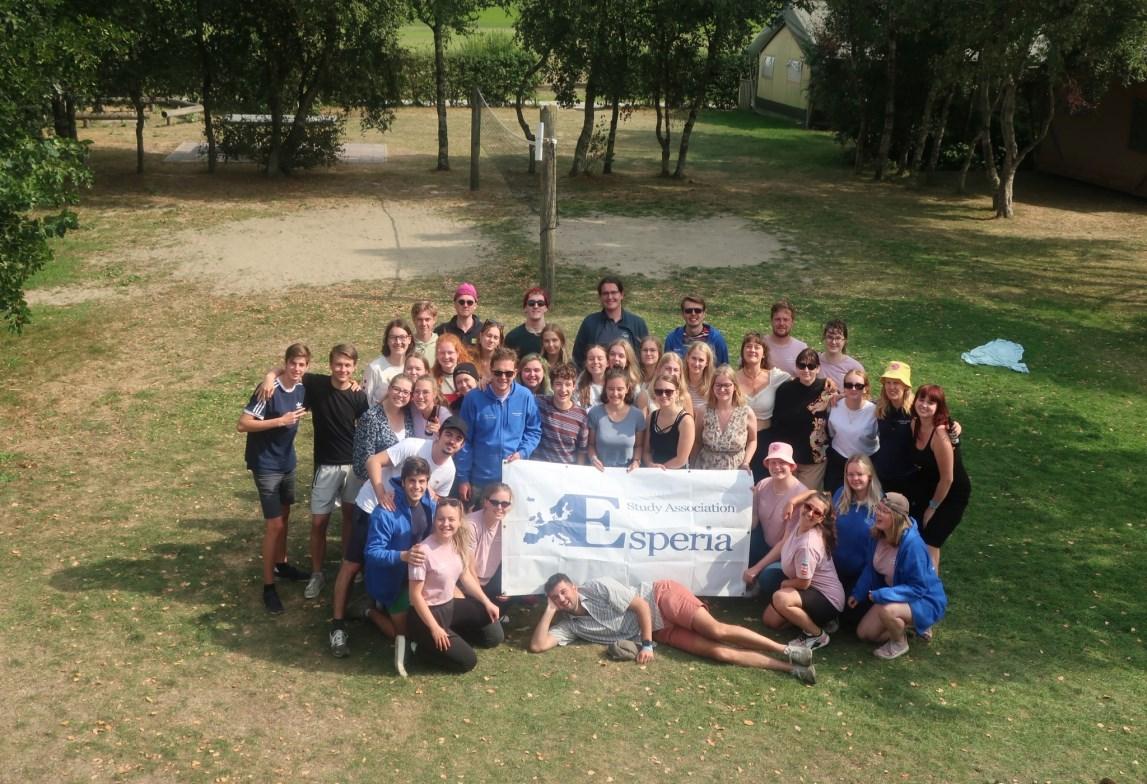
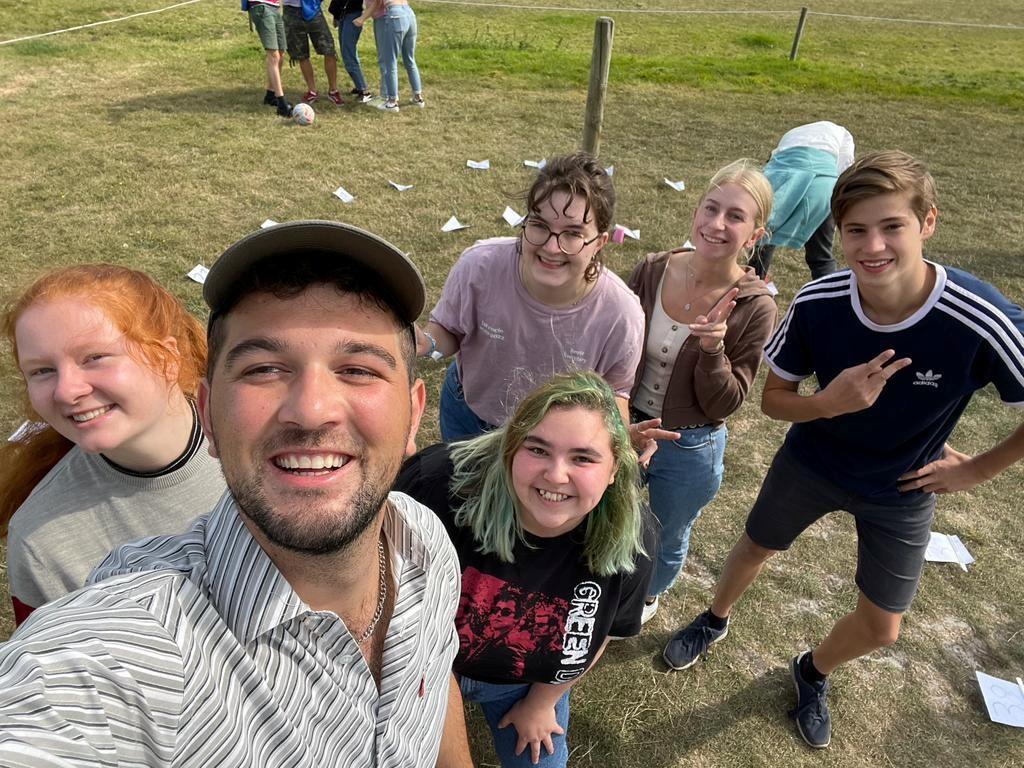
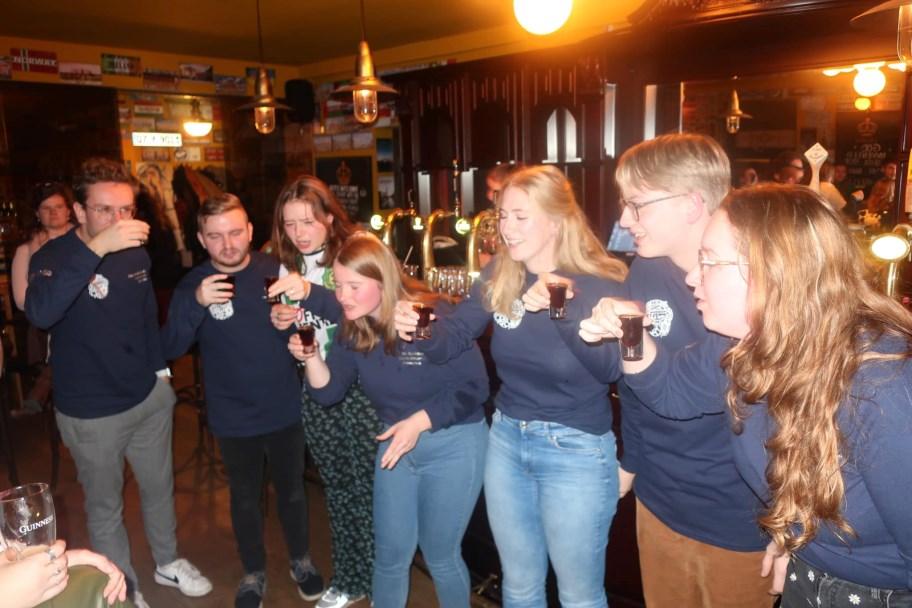
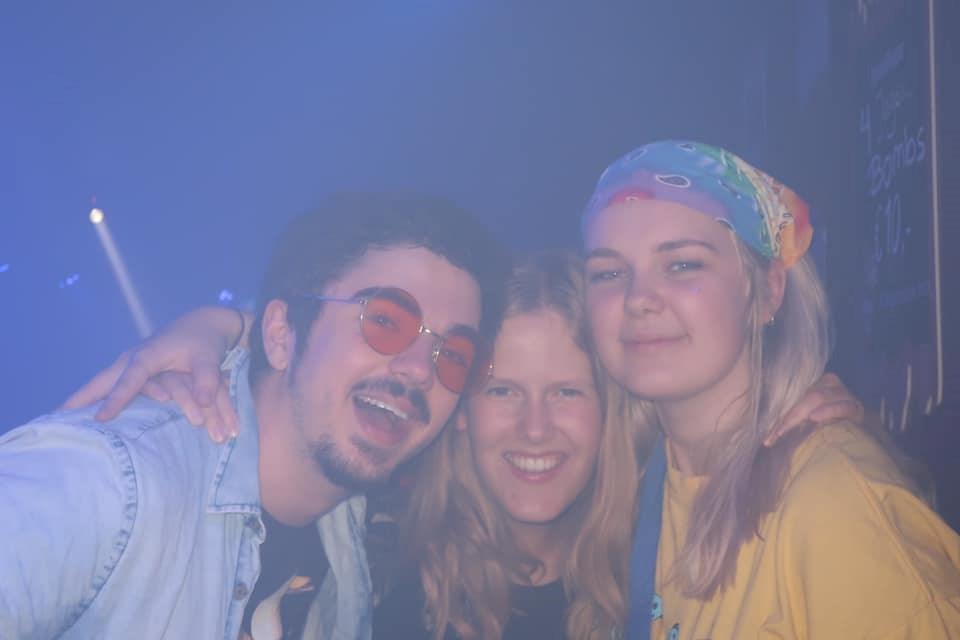





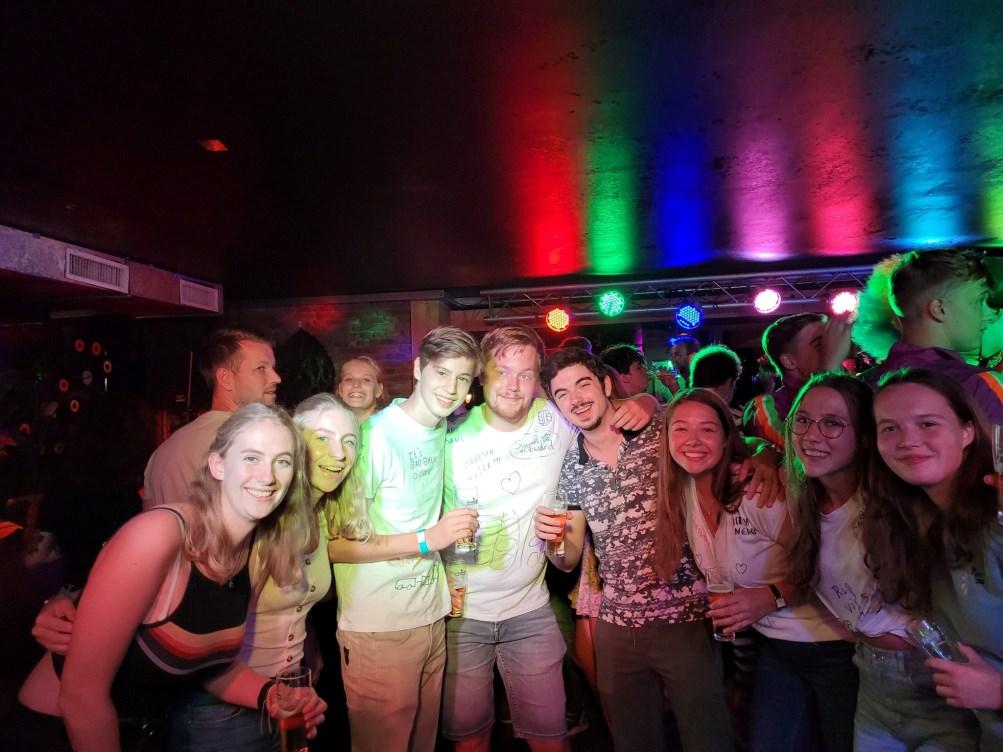

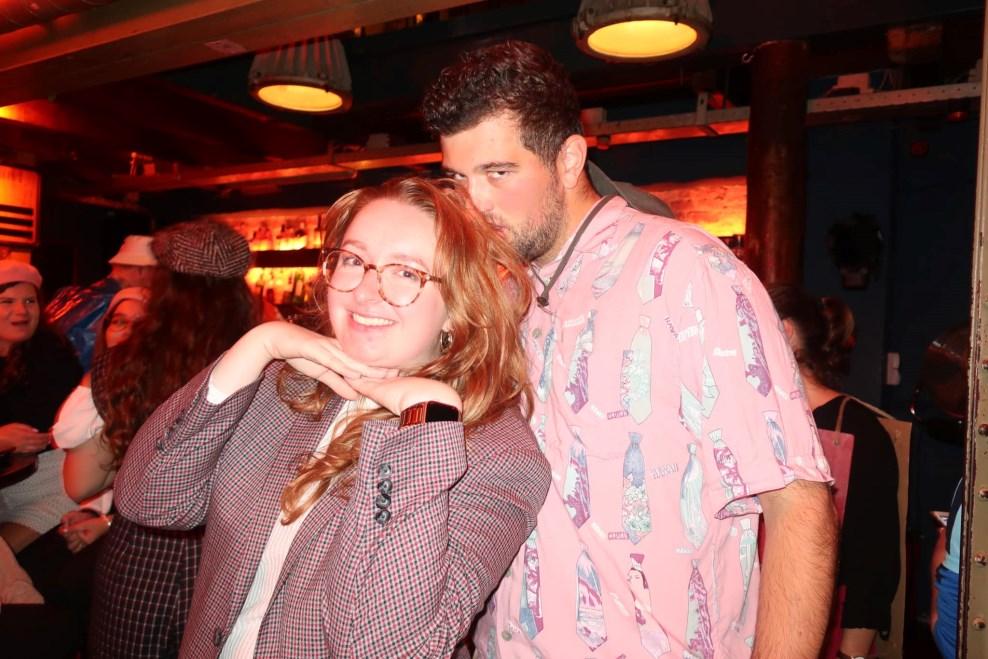

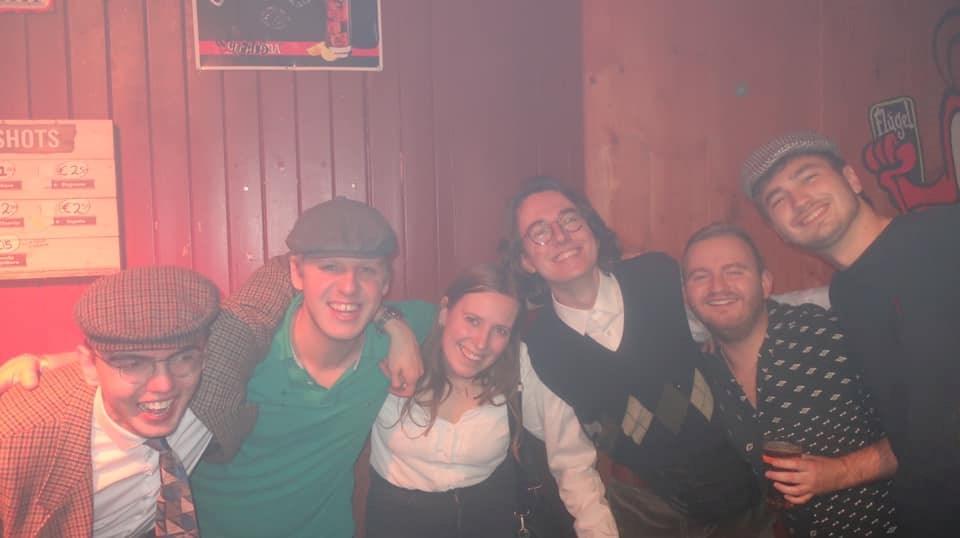
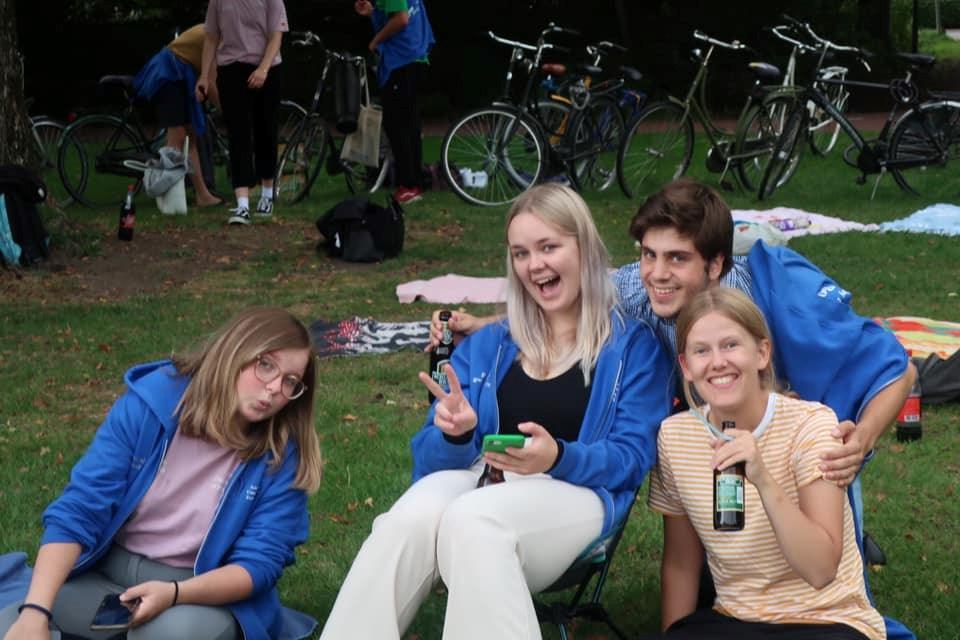


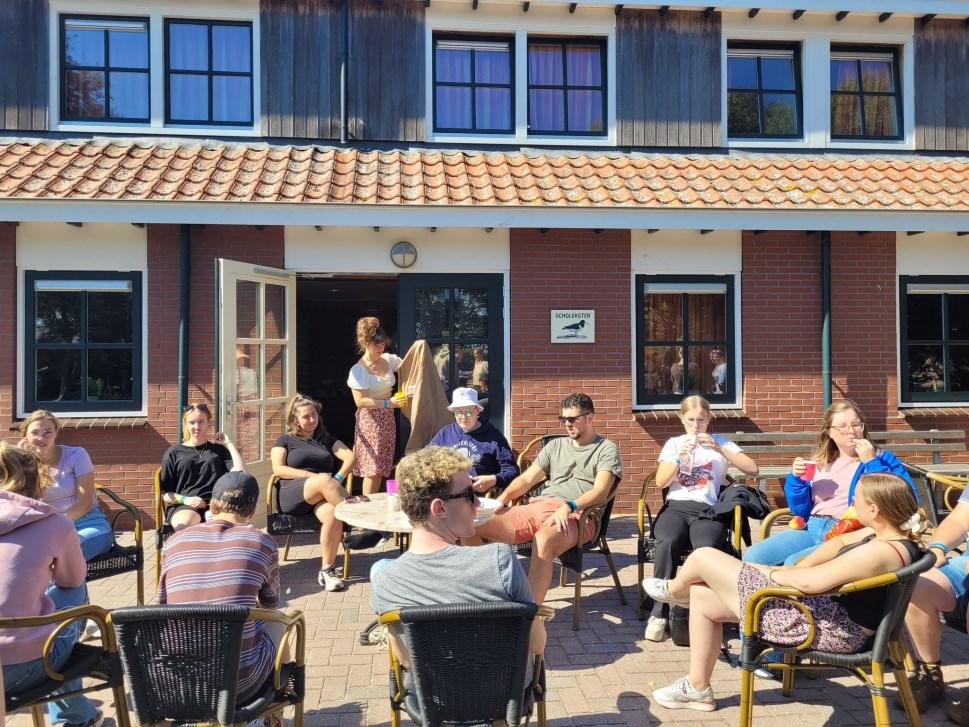
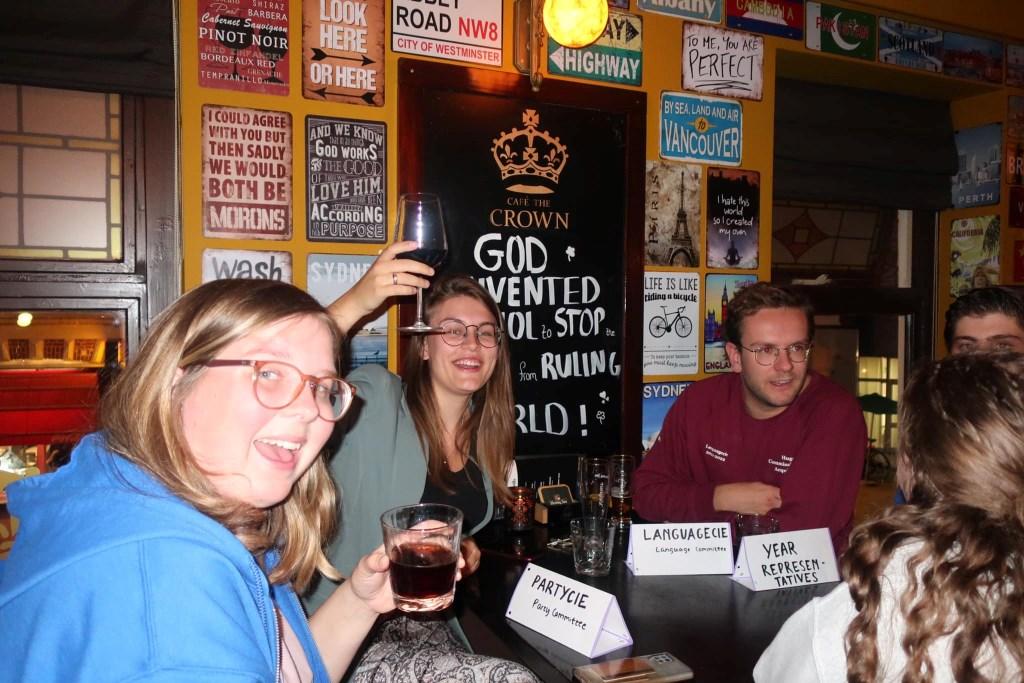



Tell us a bit about yourself!
I am a children’s literature scholar and a fairly stereotypical one since we adopted two cats during Covid. After emigrating to the UK in 2015, I moved here three years ago to teach European Languages & Cultures and Arts, Culture & Media at the UG.

I have always loved reading and during my studies, I became increasingly aware of and interested in the relationship between literature and society. Literature is closely entwined in society as human beings are storytelling beings; narratives surround us –even when people don’t necessarily read novels or poetry for pleasure. Academia is my dream career path, because it allows me to research freely, teach on a topic I love and find important, and engage with the public in a direct and independent manner.
I read you are currently working on a research project. Could you please elaborate on that?
I have two main projects. The first is on narrative constructions of truth in children’s literature, through which I attempt to discover which techniques children’s texts use to convince the reader of “what really happened” in a story. The second project is on detective children’s fiction, in which I analyse how the classic whodunit genre functions in children’s media and what this tells us about form, didacticism, and adaptation.
Since this issue concerns European folklore and mythology, I’d like to ask you: what was your favourite fable or fairy tale when you were younger? Is it still your favourite as an adult?
My strongest childhood folklore memories are oral: a fairytale series my father would make up for us during winter holidays, and a cassette we would listen to in the car. My father’s stories were the best, and have great sentimental value. I no longer have favourites, but I do have a soft spot for Hans Christian Andersen tales, as well as Irish fairy folklore.
What role does folklore play in our current society, according to you? Is it purely entertainment, as some people believe?
No art is “purely entertainment”, and folklore plays a particular role in uniting society. Folktales are even recognized by UNESCO’s Convention for the Safeguarding of Intangible Cultural Heritage (2003) as bringing people closer together and “ensuring exchange and understanding among them.” Folktales can create a sense of community, of self, and, particularly during this globalised age, a sense of understanding of the ‘Other’.
When I say ‘mythology’, what is the first thing that comes to mind?
Origin myths. Whether through religious or scientific stories, humans have always been concerned with the nature of being itself, where we come from and who we are. We tell ourselves stories to make sense of our existence; whether we believe we come from Chaos, God(s), or the Big Bang, it allows us to feel (somewhat) at peace with our place in the universe so we can focus on the everyday. Mythology also functions on a smaller level, as we create origin stories about our nations and peoples. Especially populist politicians engage in such mythologising behaviour, which partially explains their success in times of uncertainty.
Are there any superstitions you believe in or find interesting?
I find all superstitions interesting, particularly when people claim not to believe them but still enact them, “just to be safe” (ask any Irish person if they would harm a “fairy tree”!).
Any words before we round off this interview?
Reading is not required to engage with stories. Play, listen to or watch them, and remember that nonfictional stories (like the news) are tales as well!
Many people might think that the theme “Folklore and Mythology” is about stories long gone, stories about the gods in Greece or the fairies in Ireland. Furthermore, these stories are often regarded as frivolous, mere tales to marvel at before bedtime. However, the stories we tell each other for fun can have serious real-world implications. Sometimes people will use the stories of yore for the betterment of themselves, and sometimes, this is done to the extreme. In Nazi Germany, folklore was not told to get the kids to sleep, or to make an evening around the campfire more enjoyable. In Nazi Germany, stories were told to perpetrate the greatest crime in human history.
When Hitler came to power, there was one big demographic inside the country he had to get behind him: the German Christians. While indeed the Christians were not Jews, and antisemitism was as present amongst them as among almost everyone during that time, Jesus was still a Jew in everyone’s mind. To gain support for his plans from this large swath of the population, Christianity and Judaism had to be detached from each other, completely and utterly severed. While Hitler started making his plans for world domination, Nazi theologians went to work. Their job: rewrite the Bible into a holy book for the Aryan people.
The most interesting part about this story has to be the eventual conclusion that a completely new origin story should be written to include racial elements surrounding the Aryan people, if Christianity had to be detached from Judaism. Still, it is important to first look at the more “mainstream” approaches to detaching Jesus from his Jewishness. Jesus, according to these theologians, could never have been a Jew. In Nazi ideology, the Jewish “faith” (Nazis preferred to call the Jews a people or race, and Judaism an ideology in the form of Judeo -Bolshevism) was an analogue of destruction, barbarianism and unculturedness. Jesus, on the other hand, was the bringer of love, the redeemer for the Aryan people, born an Aryan and a vivid antisemite throughout his life. The Old Testament, which depicts the Jews as God’ s chosen people, was disregarded.
The new centre of the faith should be its inherent antisemitism, the New Testament should be the story of Jesus' battle against Judaism and his eventual death at the hands of the Jews.
The measures seemed to work; the majority of German Christians supported Hitler’s regime and his ideas were commonly accepted. Especially among Protestants, which were the largest swath of the German Christian populace, he was hugely popular. Roman Catholics were more sceptical, but without a strong rebuttal from the Vatican, a majority of them accepted the new reality of Hitler’s leadership. Hardliners saw Hitler as a new prophet within the Christian faith who was sent to earth to reclaim Christianity for the Aryans and reverse the East/West schism in Christianity. These people believed that Eastern Orthodoxy was the heretical faith, while others merely accepted the new status quo. Even though a lot of Christians joined the resistance, they were small minorities within their faith.
While these measures seem intense, some people within Hitler's inner circle did not believe they went far enough. Some of them, such as Heinrich Himmler, thought that Christianity which still had roots in Judaism — had to be either completely disregarded or entirely rewritten. Himmler, a Pagan and esotericist, was part of a group within the German party that wanted to put the Aryan people at the centre of creation. They wanted to achieve this by rewriting the origins of mankind, and especially Aryan people, to be separate from the other, in their eyes inferior, races. Esotericism is most easily described as a set of beliefs outside of the scope of religion with magic sprinkled in. Himmler's Paganism made him fond of Northern Europe, whose population he saw as the purest form of Aryans in the world. A few of the founders of the Nazi Party, organised in a group called the Thule Society, adhered to the same beliefs. They sought to trace back the origins of the Aryan people to an ancient continent in the North of Europe, going by names such as Hyperborea, Borealis or even Atlantis. This mythical continent had been the home of the Aryan people until the continent was lost to the sea, after which the Aryans moved to the north and west of Europe. Hyperborea was an area that is also found in Greek mythology, from which the Thule Society most likely got their inspiration.
Most contemporary historians believe Hyperborea, which in Greek meant “above the Boreal” (Boreal being the lands of Boreas, the (god of the) Northern Wind), to be modern Scandinavia, although Greek and Roman sources are vague regarding Hyperborea’s exact location. These pre-modern sources, which were assumed to be true by the Thule Society, stemmed from mythological ideas of the world; the origins of the Aryan people thus took on a more mythical form. Völkisch ideas, which took hold in 19th century Germany, told the history of the country and its people from a mythological perspective. Pre-Christian beliefs were set on a pedestal and the modernisation of society was believed to have been detrimental to Germany. The Thule Society took on many of these ideas, later believing that Hitler's idea of Lebensraum could give the Aryan people enough space to create a society inspired by these Völkisch ideas. Members of the Thule Society were fanatics, and as soon as they obtained power together with Hitler, they used these ideas as a justification for horrible crimes against humanity, which is the more commonly known part of this story.
History is grim, and although the rest of this issue will be about interesting folklore and amazing mythology in a more light-hearted tone, it is important to know and understand the other side. Fanatical ideas can be found in every facet of society, even in the stories we tell our kids or each other next to the campfire.
Book: TheAryanJesus by Suzanne Heschel (ask Stijn, he has a copy to lend)
Article: “One Foot in Atlantis, One in Tibet’, The Roots and Legacies of Nazi Theories on Atlantis, 1890-1945” by E. Kurlander
Article: “Radical Politics and Political Esotericism: The Adaptation of Esoteric Discourse within the Radical Right” by E. Asprem, K. Granholm, & J.C. Senholt
As a child, I used to send my Christmas letters to Santa in July. I also listened to the Downton Abbey Christmas Soundtrack as I wrote this article. Can you not tell that Christmas is my favourite holiday? I love nothing more than putting up the tree, singing along to Mariah Carey, going to Christmas markets, rewatching Love Actually, baking up a storm, eating incredible food and being with loved ones. Children all over the world, from all walks of life, hope to wake up to marvellous things left under their tree.
He’s the mythical man of many names; Santa Claus, Père Noël, Father Christmas, Kris Kringle, Sinterklaas. In some tales, he rides into the country on horseback, another shows him arriving by boat, and in other tales he has a magic sleigh pulled by flying reindeer. While all the stories about this man may vary from region to region, the essence of the story is more or less the same; they’re all based on the origins of Saint Nicholas.
Saint Nicholas of Myra was patron saint of many things, including unmarried people, students, and repentant thieves, but he is by far best known for being the patron saint of children. Born in around 280 A.D. in the maritime town of Myra, now modern-day Turkey, his generosity led to his canonisation and became the basis for the commercialised image of the cookie connoisseur that we all know and love today.
Very little is known of the real Saint Nicholas, but the most known story is a testament to his humility. When hearing of a man’ s destitution and inability to afford dowries for his three daughters, Saint Nicholas saved them all by anonymously slipping each daughter a bag of gold through their chimney and into stockings they’d left to dry, thus preventing the daughters from being enslaved or prostituted.
Nicholas was also the Bishop of Myra and even did time in prison during the Great Persecution, when the Roman Empire cracked down on the practice of Christianity, he remained defiant and proud of his faith.
There is another story of his miracles that is far more horrific, and allegedly how he came to be patron saint of children. Three schoolboys were lured into the house of an evil butcher and were swiftly slaughtered and pickled to be sold as ham. Saint Nicholas was in town and saw through the butcher’s wickedness, so he resurrected the dismembered children with the Sign of the Cross. This story is apparently recited to children in the West of France, I quite frankly can’t think of a better way to traumatise toddlers.
Resurrections of pickled schoolboys aside, how did this ex-con saint with a heart of gold evolve into the jolly old man in red? Well, it’ s a common urban legend that a Coca-Cola illustration is behind the modern Santa Claus, but it’s not entirely true, we need to go a little further back in time, before consumerism and unhealthy carbonated beverages…
When New York was still New Amsterdam in 1773, the Dutch brought the tradition of Sinterklaas with them across the Atlantic. Clement Clarke Moore’s 1823 poem ‘Twas the Night before Christmas takes credit for describing Santa, then mass media and consumerism took care of the rest, immortalising Saint Nick into a pop culture icon.
Things were slightly different across the pond, where iterations of Father Christmas had been around since at least the 16th century during King Henry VIII’s reign, and was seen as a spirit of good cheer around Christmas time. When the popular American myth of Santa Claus arrived in Britain in the 1850s, Father Christmas began taking on Santa’s traits and eventually, both characters became synonymous with each other.
As we can see, Saint Nick’s legacy lives on. So wherever you are, I wish you all the happiest of holidays.
with her petrifying stare and snake-like hair, was one of the three notorious Gorgons of Greek mythology, but was she really the villain that we all remember?
Believe it or not, Medusa was once a beautiful mortal. She was the exception of the family, with her sisters Stheno and Euryale being immortal Gorgons. They were daughters of the sea gods Phorcys and Ceto. The name Gorgon derives from the ancient Greek word γοργός, meaning “grim“, “fierce“, and “terrible“. But Medusa wasn't always like that. Before her transformation, she had been distinguished from her Gorgon sisters because of the fact that she was the only one born with a beautiful face. In fact, a Roman poet named Ovid, in his narrative poem Metamorphoses, ironically describes the glory of her hair as “most wonderful of all charms“. Naturally, her beauty had caught a man's eye – Poseidon's eye to be exact, the great god of the sea. It did not take long for Poseidon to act upon his desire. He ravaged and impregnated Medusa in the temple of the virgin Athena. After the sinful act, Poseidon was gone, leaving Medusa weak and helpless. Once she found out what had happened at her shrine, Athena was furious and sought vengeance by transforming Medusa into her most-known form.
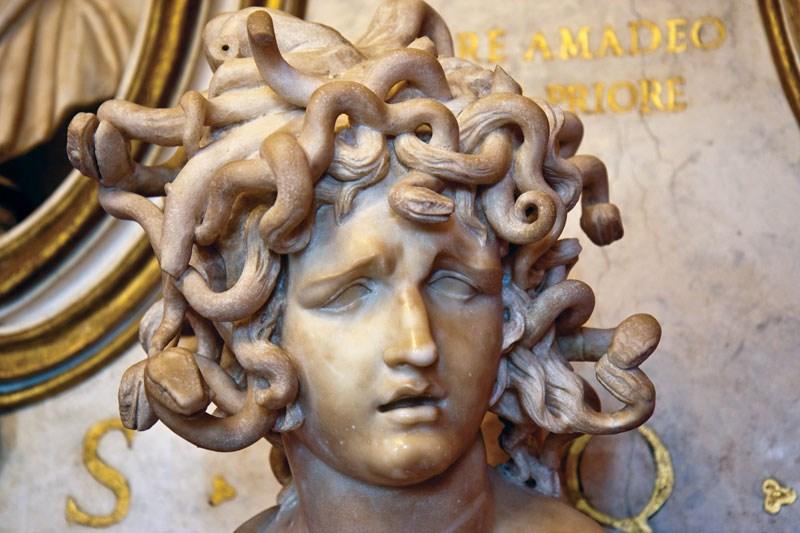
And so, Medusa was unjustly blamed and turned into a fearsome beast, a punishment for her good looks. Banished from her civilisation, she was sent to a desolate island where multiple men came on a quest to kill her. One of them was Perseus. At the request of Polydectes, the king of Seriphos, Perseus was to retrieve the head of Medusa and bring it back to Seriphos, as proof of actually killing her. Athena, still angry with Medusa, naturally helped Perseus on his quest, guiding him to look into the reflection of his bronze shield instead of Medusa's eyes. By successfully dodging her petrifying gaze, he came close enough to cut her head off with a sickle. At the time of her death, Medusa was pregnant and when Perseus severed her head, Chrysaor and Pegasus, her two unborn children, sprung from her neck. Even though Medusa was deceased, the power to turn people into stone with her eyes still existed and so Perseus used the head of Medusa in multiple ways. For example, when he came back to Seriphos, instead of bringing the head to the evil king Polydectes, he used Medusa's eyes to turn the vicious islanders into stone. After that, the island was known for its numerous rocks.
As can be seen, Medusa is wrongfully categorised as a mythological villain. She should really be looked at as a victim of the ruthless behaviour of the Greek gods. Her story is still relevant today as it highlights issues of sexual assault and the twisted repercussions that the victims often have to deal with. Medusa's curse that came as punishment can be compared to the attitudes towards unchaste women in ancient Greek society, as well as the suppression of female sexuality compared to male sexuality in both ancient and modern times. Thankfully, the approach to the myth of Medusa is changing, with Medusa becoming a symbol of female sexuality which should not be put to shame or constrained.
Old Norse cosmology, or the explanation of the universe, provides us with one of the most interesting concepts of the world that mythology has given us, the World Tree, or known in Old Norse as the ash tree Yggdrasil. Yggdrasil is widely accepted to translate to “Odin’s horse,” as drasill means “horse” and Ygg(r) is one of Odin’ s many names. Mentioned in many old Norse poems, Yggdrasil is depicted as a giant ash tree at the centre of the cosmos, encompassing the cosmos and connecting all nine worlds. In its branches and roots live many animals, all having close connections to Norse mythology, such as the dragon Níðhöggr, who lives in its roots. The stags Dáinn, Dvalinn, Duneyrr and Duraþrórr eat away from its canopy, in which an unnamed eagle sits. Yggdrasil is considered very holy in Norse cosmology, and because of this it has been depicted very frequently in paintings of old. However, it has been depicted in the modern era as well, with instances of this including games but also modern artworks. In this article I want to cover some of those instances so that you may also seek out mythology in works you would not expect it to be in.
Many games inspired by Norse mythology have obvious representations of Yggdrasil, but there are two very popular games that have their mascots inspired by Yggdrasil and its old depictions, those being Pokémon X and Pokémon Y. These games revolve around the two Legendary Pokémon Xerneas and Yveltal, and their hidden third counterpart Zygarde, who all have their origins rooted from Yggdrasil.
Xerneas, Yveltal and Zygarde are all based on different animals on the world tree, those being the stags, eagle, and snakes, respectively. Xerneas also has an idle form where it transforms into a tree, which is dubbed as “the tree of life.” These three have lore based directly from Yggdrasil, and it provides an interesting background for creatures that you would not immediately say are based on this Norse myth.
Yggdrasil is also depicted in the very popular Marvel Cinematic Universe. In the MCU, Yggdrasil is depicted as a cosmic nebula, a giant cloud of gas and dust, with each branch or root representing one of the nine realms. It is also featured on the box of the artefact of the Tesseract, a device that contained one of the Infinity Stones. This device was seen in multiple MCU movies and the Stone was very important throughout the Infinity Saga. In the Thor movies, there is a tree connected to Yggdrasil, and when Ragnarök, the end of Asgard, happens, the branches that represent the affected realms fall off, creating a more literal sense of Yggdrasil ratherthan a cosmic nebula.
Finally, Yggdrasil is featured in many artworks as well, such as the work of Friedrich Wilhelm Heine that you can see here. Many of these artworks were created in the late 1880s until the 1950s, and many are now in either Norwegian or Swedish museums or universities. Some of them are the 1933 fresco Yggdrasil by Axel Revold, a painting by K. Ehrenberg from 1888 called Die Nornen, and a wood relief carving called Hjortene beiter i løvet på Yggdrasil asken on the Oslo City Hall by Dagfin Werenskiold.
Yggdrasil is one of the most important names in Norse mythology and cosmology, and to this day, its name and image have not been forgotten. It is still very often giving inspiration for game visuals, artwork, and movies, both directly and indirectly. There are many examples that I did not manage to cover, or many other Norse myths that still hold fast today. I would strongly encourage you to seek out cosmology in many other modern media or artworks. They might be inspired by incredibly old mythologythat you would not immediatelyexpect.
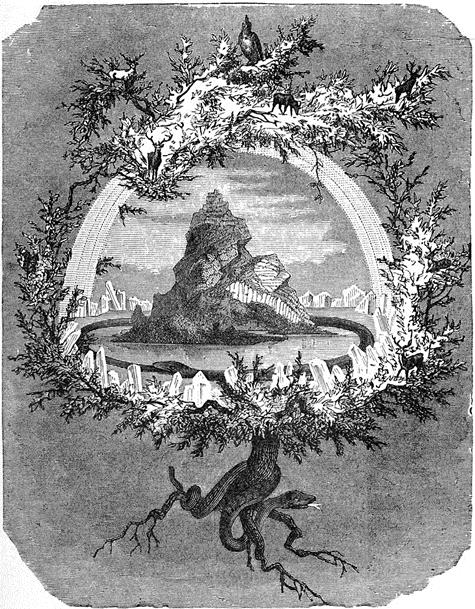
Butterbeer was an actual historical beverage, not just one enjoyed by wizards; this recipe is adapted from a 16th century Elizabethan cookbook. Butterbeer was the lovechild of the pumpkin spice latte and eggnog (advocaat for our Dutchies). For this decadent recipe, Koos recommends beer low in hops for historical accuracy (the English did not use any hops when brewing in 1588) and to prevent any bitterness that comes from using lager or IPA. Butterbeer is best served warm but is also delicious chilled. There is also a non-alcoholic step; now everyone can enjoy this taste of history!
- Beat egg yolks with sugar until light and frothy, set aside.
- Pour ale into a deep saucepan, avoid creating too much foam. Whisk in the spices.
- Over medium heat, bring mixture to a light boil before lowering flame to simmer on low heat for about 2 mins.
- (For non-alcoholic butterbeer, leave boiling mixture on medium heat for 20 mins)
1500 ml good quality British ale
5 egg yolks
¼ tsp ground ginger
½ tsp ground cloves
½ tsp ground nutmeg
113 g dice unsalted butter, cubed
175 g demerara/ dark brown sugar*
- Once simmered, remove pot from heat, then whisk in sugar/egg mixture. Keep stirring constantly to prevent scrambled yolks. Return to low heat and simmer until liquid thickens slightly (may take around 5-7 mins to see change, be patient, do not be tempted to bring to higher heat).
- Once thickened, stir in butter until melted, then still on low heat, keep frothing beer with whisk before simmering 10 mins.
- Remove saucepan from heat, let beer cool to a warm temperature.
- Whisk aggressively before serving in mugs.
Mix one part chilled beer with one part cold milk to enjoy Butterbeer whenever, wherever!
* The Tudors loved sugar, and it was a status symbol. The original recipe requires 225g of sugar, follow at your own risk; your dentist might hate you
Even the tiniest of countries can be the greatest of storytellers. Now, folklore is no competition, but the Dutch did play a key role in the birth of Santa Claus (go read Tiara’s article if you haven’t yet!) and the legend featured in Pirates of the Caribbean: Dead Man’s Chest – the highest-grossing film of 2006! – did originate in the Netherlands. All bragging aside, this country has a plethora of folktales and myths to offer. Interestingly, the Dutch seem to have a weak spot for the more uncanny tales, so here are two captivating stories, carefully crafted to give you the creeps.
World-renowned is the legendary Flying Dutchman (NL: De Vliegende Hollander), a ghost ship doomed to sail the seven seas for eternity after being possessed by the Devil himself. It is thought that the inspiration for this legend stems from Frisian captain Bernard Fokke; he sailed the distance in half the time(!) it usually took to get from the Dutch Republic to Java. People even accused Fokke of making a pact with the devil to travel at such speed. The story of the Flying Dutchman has been told many times in many ways; according to one version, it all started when Dutch captain Willem van der Decken insisted on sailing out to the East Indies on Easter morning despite terrible weather conditions. After all, there was an ongoing power struggle to get to Batavia as quickly as possible, meaning the captain did not have time to waste. After a long travel, the ship reaches the Cape of Good Hope, close to the southernmost tip of Africa, and Van Der Decken demands to sail around it despite his crew’s pleas to return to Table Bay nearby.
The captain then throws his mate overboard in a fit of rage and cries out: “God or the Devil, I shall round the Cape, even if I must sail until the Last Judgement!”, thus cursing the ship to sail around forever. According to the legend, if hailed by another ship, the crew of the Flying Dutchman might try to send messages to land, or to people long dead, and as thrilling as a ghost ship may sound, you do not ever want to encounter the Flying Dutchman with its blood-red sails: it is an omen of impending doom in ocean lore, and your death will be imminent.
Think you are safe from ghosts by staying on land? Think again. If you have ever wandered through a foggy forest, chances are you were surrounded by the spirits of wise female herbalists known as witte wieven. From chasing you down on your horse to helping you during childbirth, these female spirits truly are capable of making or breaking your life! They have many names across Europe and share traits with Celtic-Irish banshees and the Spanish-Mexican La Llorona. According to legend, witte wieven reside in their burial sites or other sacred places and are always dressed in white, hence their name; in modern Dutch dialect, witte wieven literally translates to “white women”, though it originally meant “wise women” because of their fortune-telling abilities. After the introduction of Christianity in the Middle Ages, however, the witte wieven gained a more negative connotation: their playful harassment was rebranded into death and destruction. Still, the Dutch stories preserved certain aspects of the old traditions: the ladies were not only associated with evil deeds, but they could also help you finish the job in exchange for an offering. Next time you find yourself near a grave hill around nightfall, it is best to bring some pancakes (their favourite snack!) and stay civil lest you disappear into the mist. Oh, and never challenge a wit wief to a dance battle like a drunk farmer from Beek once did; the stand-off will not be the only thing you lose.
When I think of European folklore, few stories and plays have been as influential for European cultural history as the ancient Greek plays from Aeschylus, Sophocles and Euripides. Their plays were written for the Dionysia, a prominent religious festival in honour of the Greek god Dionysos. All won several editions of the contest, with their works still being popular and put into play to this date.
The plays performed at the contest were often retellings of old folklore. Each playwright wrote with a different philosophy in mind on the subject matter and the role the characters played in the story. In rough terms, one could say Aeschylus wrote while taking in mind the relationship between humans and the gods, Sophocles wrote on how humans should behave, while Euripides focused on human behaviour as it is. It is exactly Euripides’ philosophy on playwriting that makes him a favourite of mine and whose works I would definitely recommend to anyone interested.
It is interesting how Euripides paid attention to women in his plays. In Elektra, he wrote about how Elektra saw herself as a victim of her mother’s behaviour while also exploring how this affected her growth as a woman. Already in the fifth-century B.C. Euripides wrote plays from a female perspective. Which, when put into the context of said time, where women were deemed significantly less important than men, is remarkable to say the least.
As remarked earlier, the plays of Aeschylus, Sophocles and Euripides are still out in theatre productions to this day, with their messaging still relevant to current societal discourse while being based on the folklore of that time. It is folklore through and through, a cultural representation that is both ancient and capable of being contemporary at the same time. In its essence, folklore is timeless and a core construct of our ever-changing identity as humans.
Now that you have read most of these stories and are either obsessed or done with folklore (of course it is the first one), you might want to keep these vibes going. You can do this by reading more folklore or trying to learn more about the aforementioned stories or even looking at the stories of your own culture. Another way to do this, which is one of my favourites, is by listening to music. Here are some albums to keep you in the same vibe, either through the music itself or their lyrics.
This album delves into English folklore, with all 11 songs inspired by the legends and stories of Devon and Dartmoor. While there are also typical folklore songs like the title track Kitty Jay and Farewell My Love

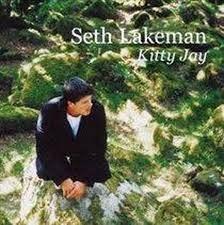
This one could obviously not be left out of this list. This album is all about storytelling, and does this amazingly in its songs. Cardigan, betty and august are all connected through the same story, but from different points of view. Whereas the lakes is a song about poetry and conveys a real folkloric feeling.

This album is infused with West African folktales by British-Nigerian singer Eno Williams. With songs like Voice of the Bird, The Tortoise and Prodigal Son. It offers a fresh take on Ibibio folklore.
I hope you enjoyed these albums and if you want more, here are some other albums for you to check out: Notes for a Maiden Warrior by Dani Larkin, Hadestown by Anaïs Mitchell and Kvitravn by Wardruna. For even more folkloric music inspiration ask Sander!
We have come to the end of the very first edition of the ETCetera this year. We hope you all enjoyed perusing through this edition. Yes, it was a bit more academic than you were used to, but we hope you learned something, and had fun reading it.
We would like to thank the Charicie and Sjoerd for writing their respective pieces for our magazine – the former introducing us to this year's charity and the latter giving us an interesting piece of Greek Mythology – as well as Dr. Veldhuizen for taking the time to answer our questions.
As stated before, you can always ask us if you want to know more about some of the stories or the topic in general. All of us would be more than happy to tell you all about it.
At our very first meeting when we decided on our theme, one thing came to mind as we thought of mythology. While we sadly could not incorporate it into the magazine, we did want to leave you with this final piece of information. Some might already know it, for others this is the first time, and still everyone will enjoy it: the national animal of Scotland is the unicorn.
That’s it for this time, thank you all for reading and we hope to give you another edition of our lovely magazine soon!
Love, Tiara, Paula, Anne-Roos, Bart, Stijn,
Ruben and Koos
